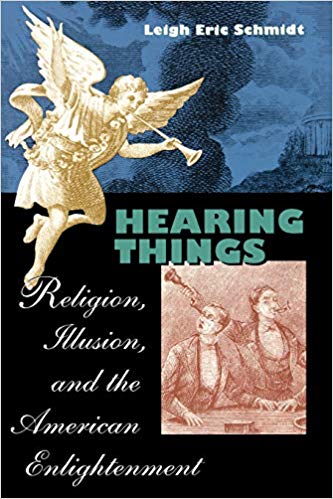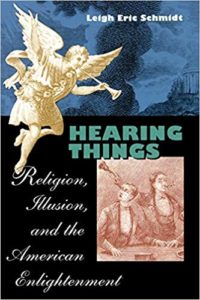Supernatural Sounds and Enlightenment Silence

In The Questioner of the Sphinx (1863), a painting by the American artist Elihu Vedder, a man in a desolate desert landscape kneels before the giant stone head of a sphinx, pressing his ear to the ancient stony lips. The modern Questioner still asks, but Vedder’s sphinx is blank and silent. For Leigh Eric Schmidt, in his fascinating new book, Hearing Things: Religion, Illusion, and the American Enlightenment, Vedder’s stark vision of spiritual alienation is emblematic of “the oracular silences that had descended upon some modern listeners” (130). Enlightenment science and modern rationality re-tuned the ear, nullifying what were once considered to be the voices of oracles, angels, or God as trickery or madness. But that is only half of the story, for even in today’s secular America millions still claim to hear divine voices and supernatural sounds. Schmidt’s book traces the complex relationship of these two historical processes: how modern science disciplined aural perception, and how popular spiritual practices that place a premium on spiritual “hearing” persisted nonetheless.
This is a work of impressive research, sparkling intelligence, and grand sweep. The publisher will surely be able to find a reader who will call it “a brilliant tour de force” for the dust jacket blurb. In a philosophical prolegomenon, Schmidt examines twin interpretive narratives that, he argues, have obscured the study of modern hearing. The first contends that the modern obsession with vision, optics, and literacy displaced traditional aural and oral cultures. The second mourns the loss of divine presence in the secular disenchantment of the world. Schmidt tells a more complicated and interesting story. His second chapter, “Sound Christians,” focuses mostly on noisy eighteenth- and nineteenth-century evangelicals, and describes how they practiced a religion of the ear. Converts’ spirits were stirred by impassioned preaching and hymn singing, and moved by holy laughter and ecstatic barking at revival meetings; some claimed to hear mysterious voices in otherwise empty rooms or angelic choirs at their deathbeds; still others tried to describe their new spiritual perceptions as in some ways analogous to listening. (Elsewhere in the book, Schmidt unfortunately collapses these experiences into the single category of pre-modern “hearing.”)
The freshest and most engaging material in Hearing Things, however, comes in chapters 3 and 4, “Oracles of Reason” and “How to Become a Ventriloquist,” which together account for nearly half of the book. The developing science of acoustics allowed Enlightenment philosophes and the Christian literati to explain how ancient priests could have made their idols speak to dupe the credulous. Figuring out the ventriloquist’s tricks also helped the learned demystify mysterious sounds. Speaking tubes and “talking” statues not only led to new forms of entertainment that would be exploited by showmen like P. T. Barnum, but provided a technology that supported the disciplined senses of Common Sense epistemology (once we learn how the eye and ear can be tricked, we won’t be tricked again). Techniques that could duplicate what were once taken to be religious marvels also supported the Enlightenment’s natural history of religion, which swept away a world of wonders as merely devious priestcraft and the delusions of the uneducated. Schmidt moves from Renaissance magic to experiments in acoustics to Thomas Edison, and from treatises on witchcraft to Charles Brockden Brown’s novels to alienists diagnosing hallucination in their new insane asylums. After this virtuoso performance, Schmidt’s last chapter, “Voices from Spirit-Land,” is a bit of a disappointment. He spends too much time paddling around in what he admits is the “small pond” of the Swedish mystic Emanuel Swedenborg, and then hurries to a conclusion (228).
Schmidt’s preface tells us that the book is not “a nostalgic retrieval of a soundscape supposedly lost to modernity” (vii). He denies that his own “thinking about the presences in voices” is grounded in metaphysical or theological presuppositions, and tries to dragoon French phenomenologist Maurice Merleau-Ponty into philosophical service (33). But the author’s sympathies are evident throughout. He repeatedly describes the Enlightenment pursuit of reason and knowledge as “dreams” and “fantasies.” Debunkers of religious claims offer chimerical explanations and they perform “interpretative sleight-of-hand,” whereas their pious opponents are “especially perceptive” (116, 152). In Schmidt’s view of Enlightenment science, there seems little room for awe and joy in learning about the wonders of nature; it is all about containment, mastery, and the will to technological power. The romantic art that tried to replace religious faith is inevitably hollow (modern statues, after all, don’t cry, bleed, heal, or talk). Moderns like Elihu Vedder are alienated, lost; their landscape is silent, the meaning of life is diminished. Schmidt’s evangelicals and mystics, however, seem to open up rich new worlds of possibility. The prayers of a man convinced that he saw John the Baptist driving a chariot are called “poignant,” while his physician’s insistence that this was a hallucination is said to be driven by an obsession with policing religious experience (197-98). Schmidt’s believers are neither scary nor silly: they aren’t the ones who heard voices telling them to slit their own or someone else’s throat, or who merely heard spooks that went bump in the night.
Early in the book, Schmidt says that he will forgo the popular sport of Enlightenment bashing. It’s true–we don’t hear the buzz saw of Theodor Adorno and Max Horkheimer’s famous critique, Dialectic of Enlightenment (1944). But one can catch the faint tinkling of New Age religious sentimentality as the author describes the silence created by the Enlightenment sensorium. As Schmidt gently mocks the philosophes and debunks the debunkers, one can detect the tone of an intellectualized neo-spiritualism that claims a wisdom more capacious than modern common sense or postmodern skepticism. He is more suspicious of modern rationality than of those who claim to hear voices from their god’s stony lips. Readers who don’t always put the word “superstition” in quotation marks, or who think that a mental patient’s auditory hallucinations might have more to do with bad brain chemicals than with God or bourgeois social constructs, might not agree. Still, the history in Hearing Things is well worth listening to.
This article originally appeared in issue 1.2 (January, 2001).
Christopher Grasso teaches in the History Department at the College of William and Mary, and is currently Acting Editor of the William and Mary Quarterly.
